Roni
Member
Hi,
The previous trip report part:
India 2012 - 18: Goa - Diesel in Paradise I: Kickoff! (50 p.)
http://railroadforums.com/forum/showthread.php?t=40388
The accompanying video:
http://www.youtube.com/watch?v=Ln9ntoVBVts&hd=1
As promised we start this trip report part with an overview of railway lines in Goa. On one hand these entail the Konkan Railway westcoast mainline, leading from Mumbai suburbs (Roha) via Goa to Mangalore (Tokur). The complete route of 738 km total was opened in 1998, the reason for this late build was the rugged terrain of the coast region called Konkan. It consists of broad river deltas with swamps and mangrove forests as well as mountainous areas. More about the railway here: http://en.wikipedia.org/wiki/Konkan_Railway
The other railway line is the original route, which climbs the Deccan Plateau through the Ghats as we already have seen elsewhere. Until the completion of Konkan Railway Goa could only be reached via this detour. The mountain line from Kulem to Castle Rock is called Braganza Ghat, supposedly after a shepherd who had discovered this passage. Castle Rock already lies outside of Goa and previously served as toll station for the former Portuguese colony. The line leads to the most lively town of the region, Madgaon (also Margao), then parallel to the Konkan Railway and from Majorda as branch line to Vasco da Gama. Broad gauge infrastructure is relatively new here, as often in India this used to be a metre gauge line operated by steam. Ranjit from Pune told me a nice anecdote from his childhood when steam drivers used to stop at his house because they knew he would serve them tea. It simply was a different time and life pace back then.
I marked all important spots which will occure in the reports. Next a local train journey to Kulem was scheduled. On the route Vasco - Kulem three local passenger train pairs were operating, further on Braganza Ghats there was no regional traffic anymore, shown stations did not feature any regular stops. Some tourists and natives were using banking locos for local rides.

18. 2. 2012
Early in the morning a commom guest on the lawn outside my room, later I would catch it in sunlight as well.
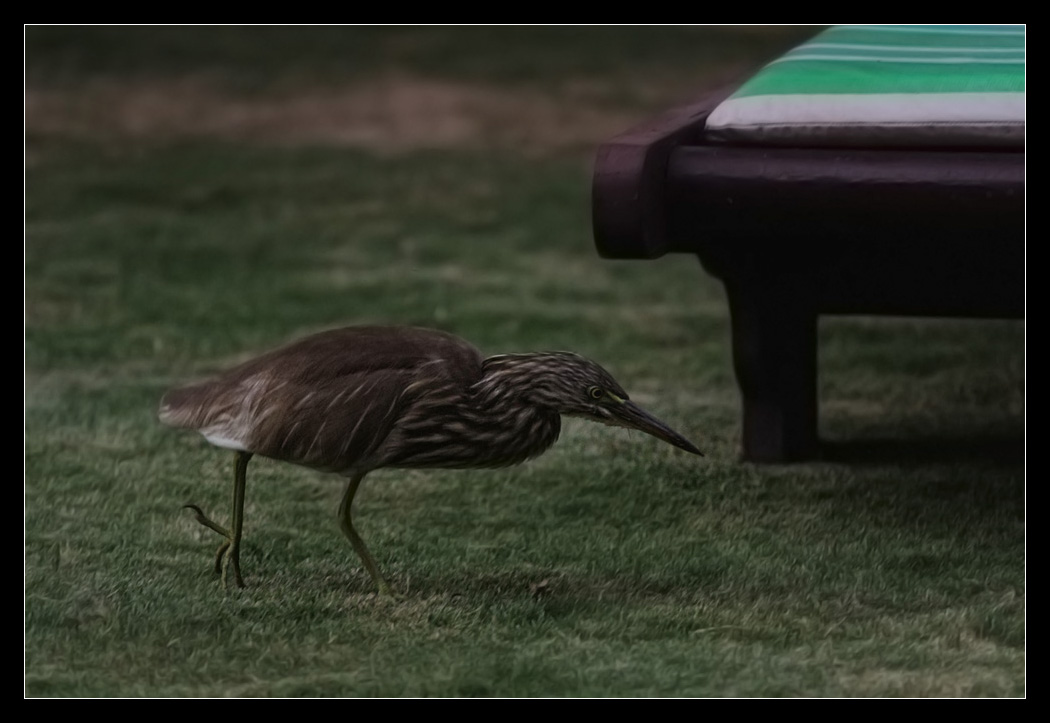
This was supposed to be the Goa exploration day, I hit the road at 6:30 a.m., three kilometres on foot as taxis in Goa could mainly be caught inside the centres, in front of the resort only at later times. However, it was no problem to reach Majorda station. On the way I already acquired a taste of the different, but equally not-so-different culture of Goa compared to the rest of India. Christianity was practiced the same way as most other religions: with shrines everywhere, large inscriptions on vehicles and painted figurines, in other words: loudly and colourfully. On the road I came across a minibus with the windshield-wide writing "Ratzinger". I crossed the centre of my village, Betalbatim, with school, shops and church. Everything exuded the mood of a mixture between India and Brazil.
The parish of Betalbatim was founded in 1630, the current church "Our Lady of Remedios" originated from 1809.
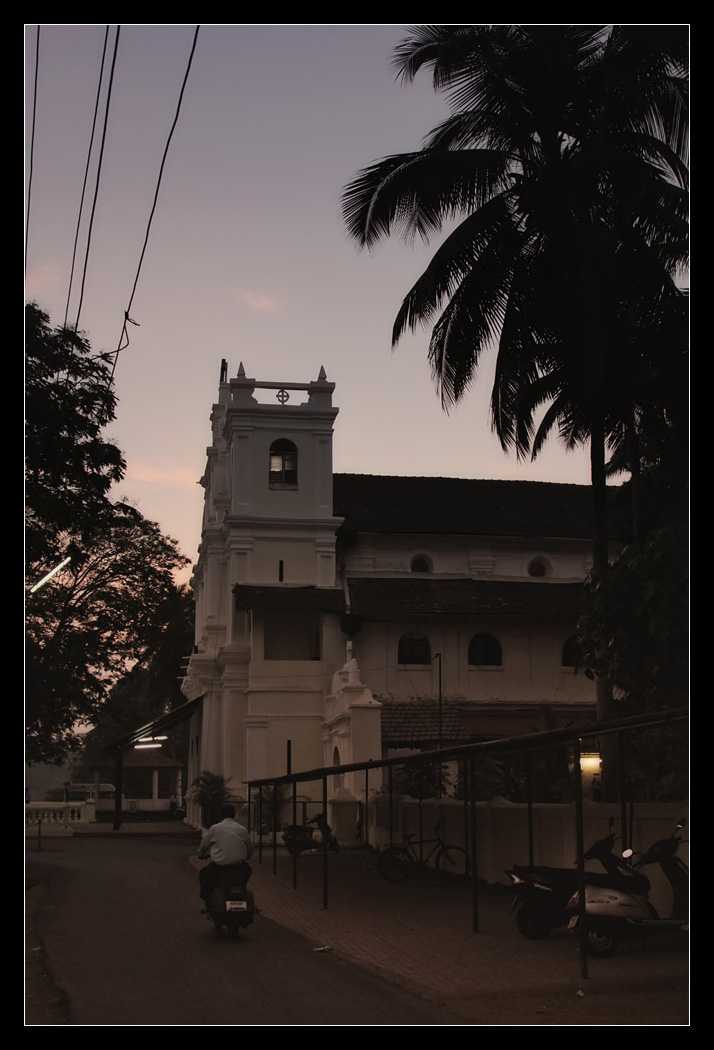
Subsequently I had to walk cross country, on fields and swamps a picturesque layer of ground mist had formed.

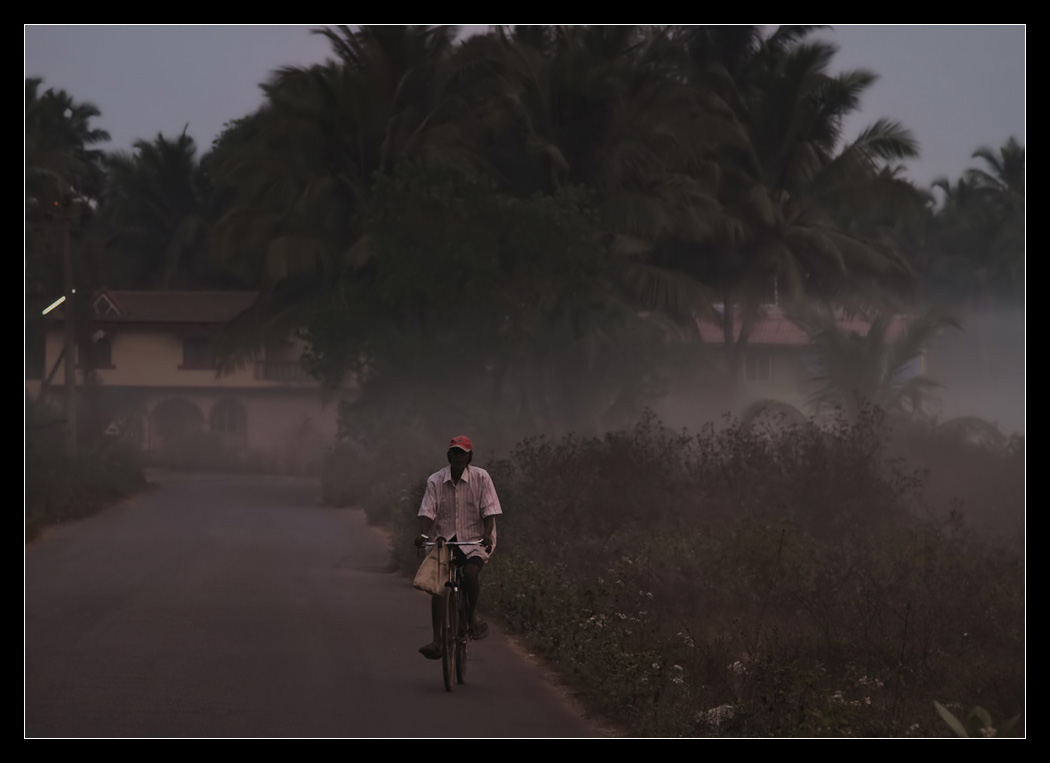
Foggy sunrise.


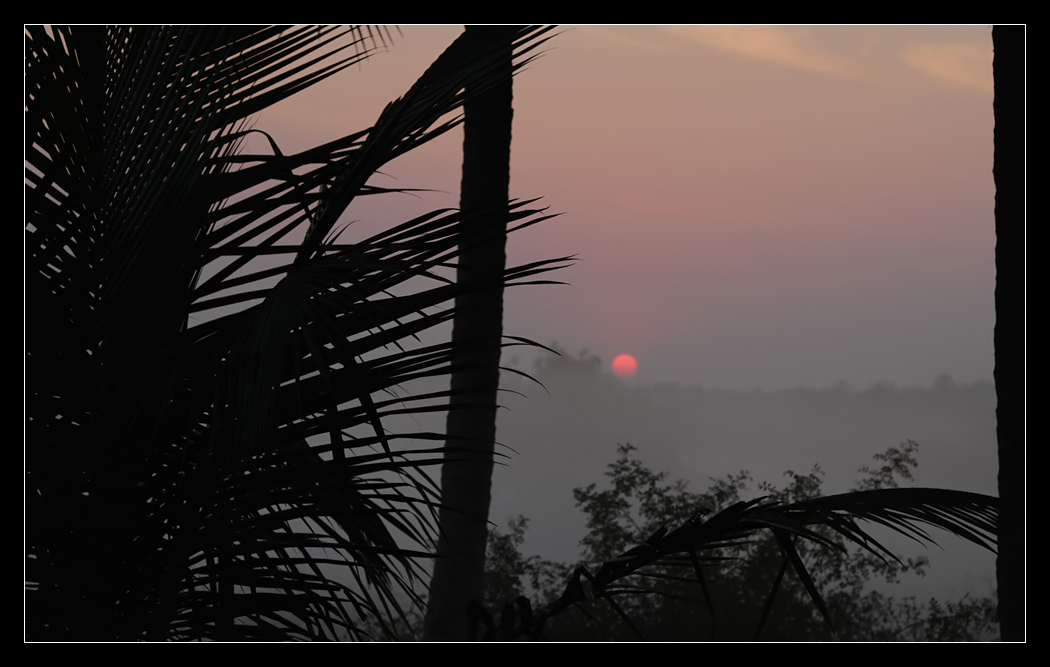
The final road section up to Majorda.


Yeah, right!
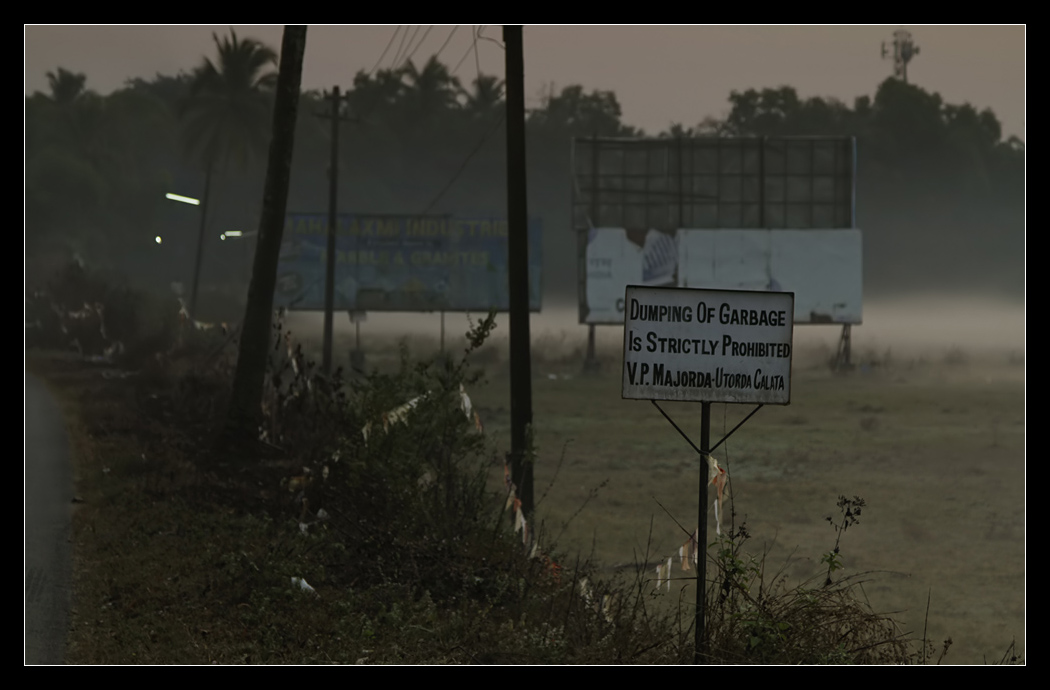
Once more a little different than the rest of India!
Below: a Nokia ad.

Yes, my favourites in India: faded advertisement paintings.
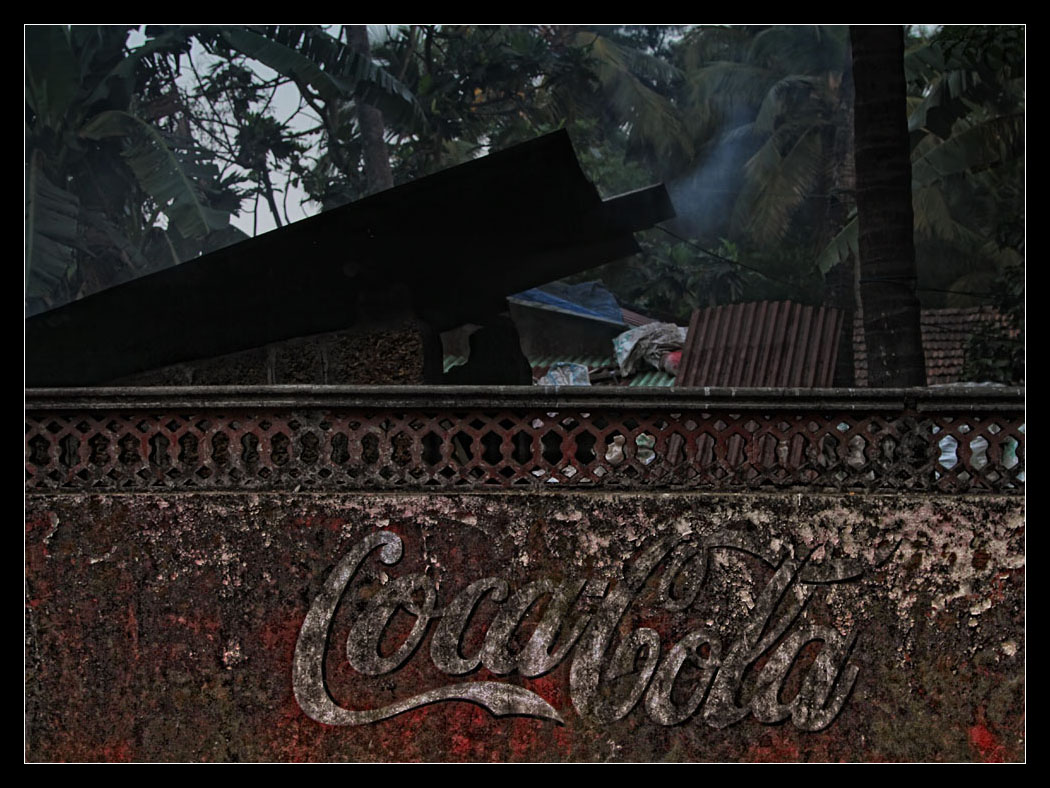
Finally arrived at the level crossing north of Majorda Junction, spanning both parallel lines.

Many schoolchildren passed by, in the foreground the level crossing barrier crank.
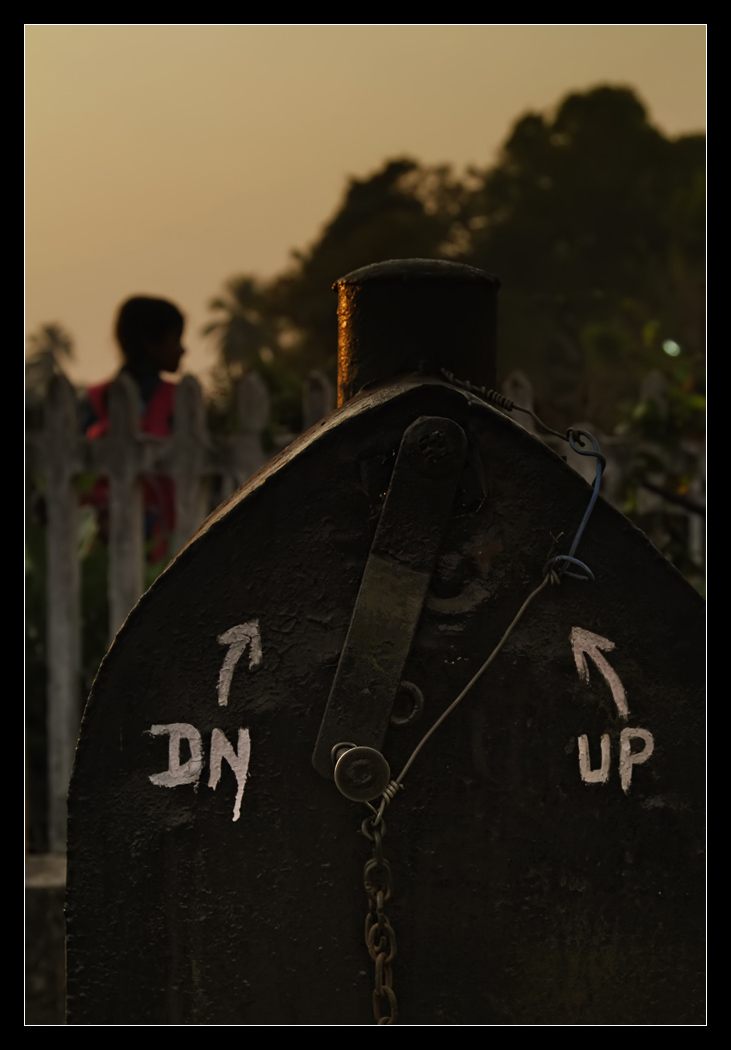
I handed a copy of my photo permit to the crossing guard, who later talked on the phone about it, often laughing. General mood seemed to be quite relaxed here, and of course people were used to tourists taking pictures.

Old list of gatemen on the wall below the roof of the hut, probably this method of data storage was not in use anymore.

I waited for the Kulem Vasco passenger which was supposed to depart earlier than my train, crossing it at Cansaulim as can be seen in the previous report. But nothing happened at the scheduled time and the guard told me that the train to Kulem would come first. So, I walked along the tracks towards the station. Shortly later a bell sounded at the crossing and I took up position behind a stabled freight rake.
The gates were still open but in the back you could already spot an express approaching on the Konkan Railway, to the left the line to Vasco, it branched off a little further north.

The gateman did his duty, and the barriers were closed.

Ernakulam WDM-3A pulled 16335 "Nagercoil Express" towards its destination at the southern tip of the subcontinent.

Cocos dominated the surroundings.
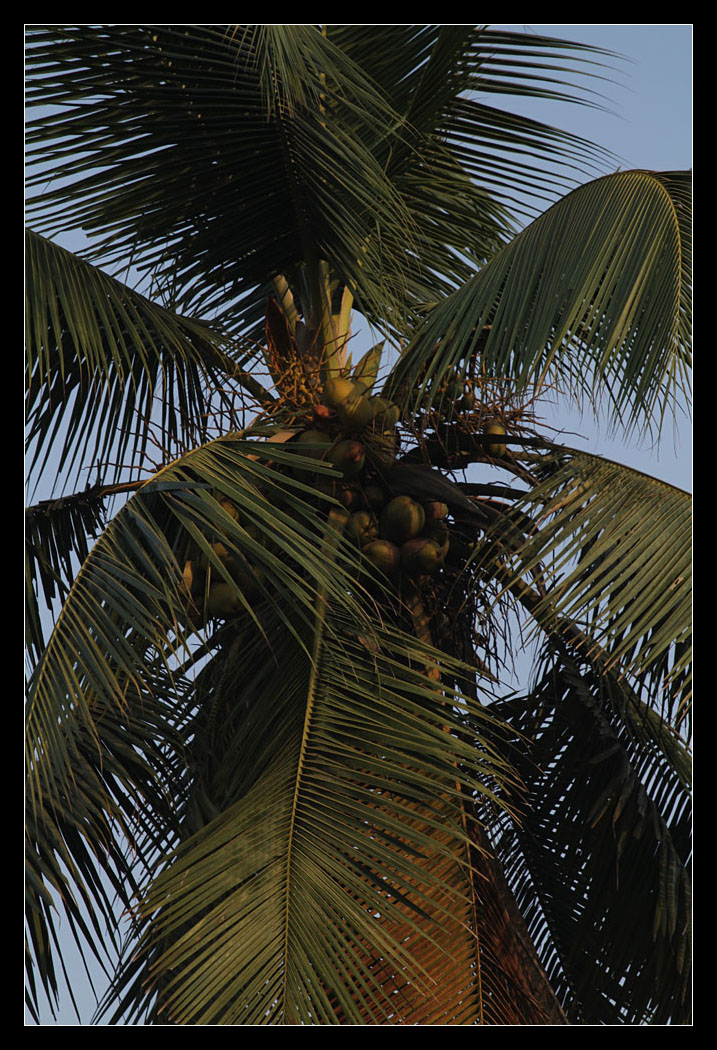
I moved to platform 1 of Majorda Junction, but finally 56961 Kulem - Vasco Passenger came first, about 20 minutes late.
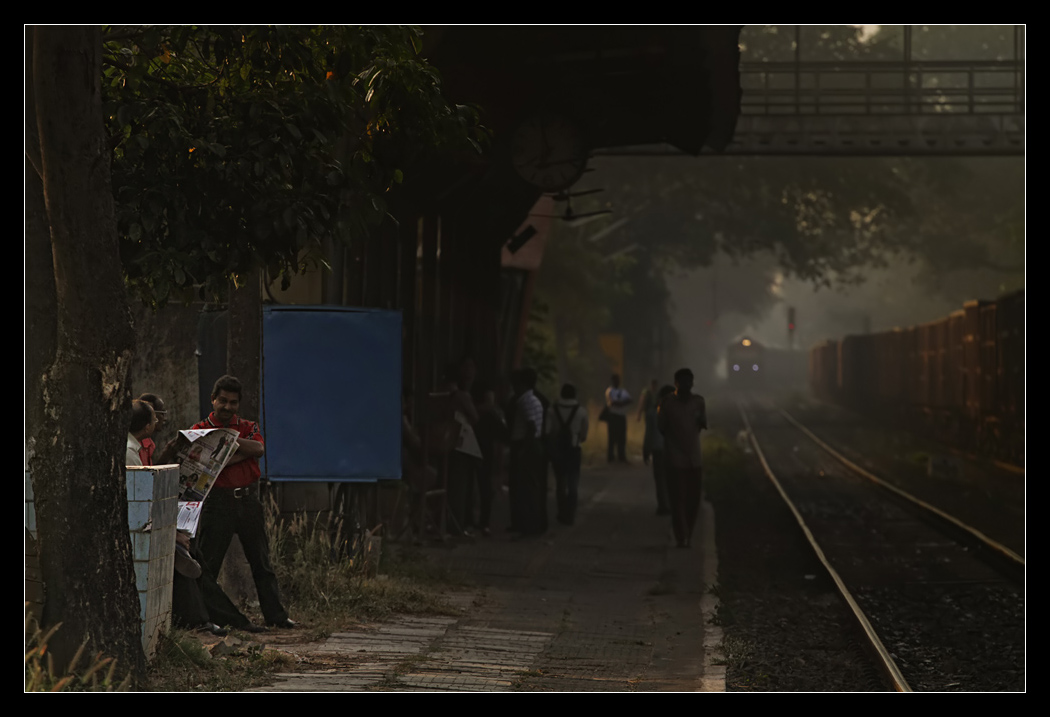

Like on the day before a tractionless freight rake stood on the middle track.
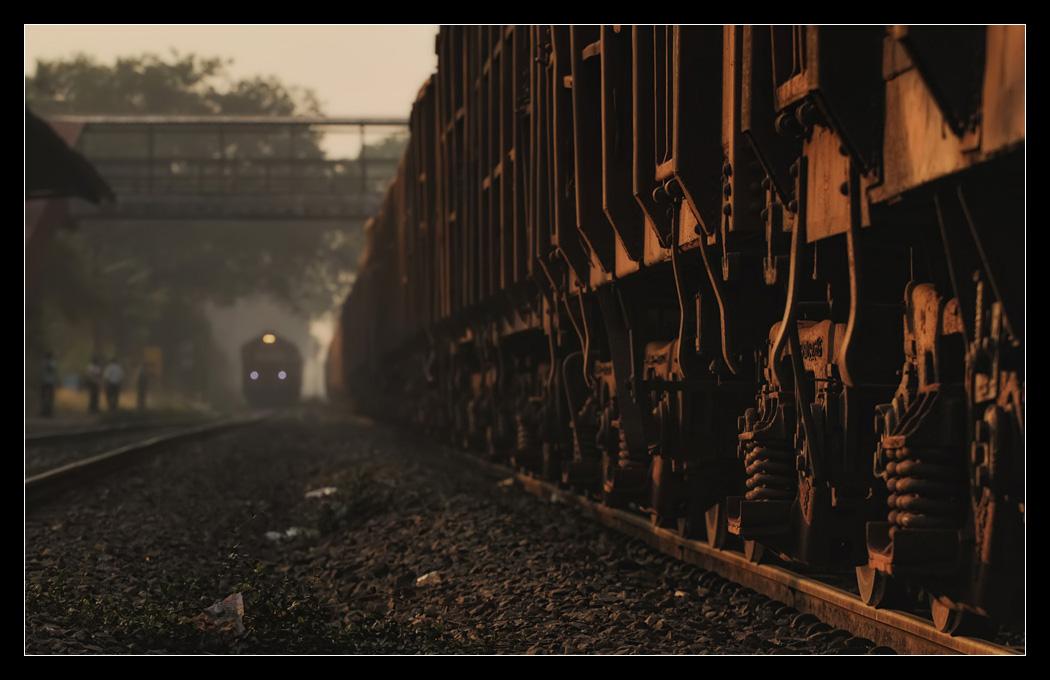
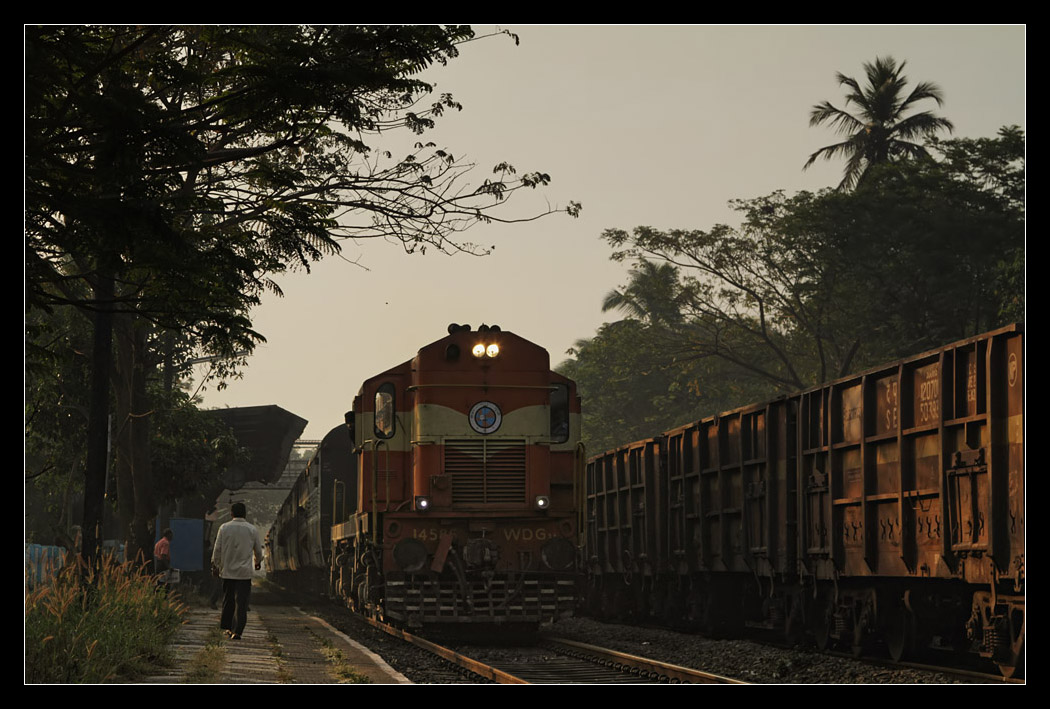
The locos of both local trains remained the same during my stay, here once more Gooty WDG-3A 14586.

From now almost all photos were taken by compact camera.
I chatted with the loco crew, they thought their train would depart first.

I prepared for a video shot, but then they called me back because the other train was already nearing as can be spotted in this tryout of a painting.
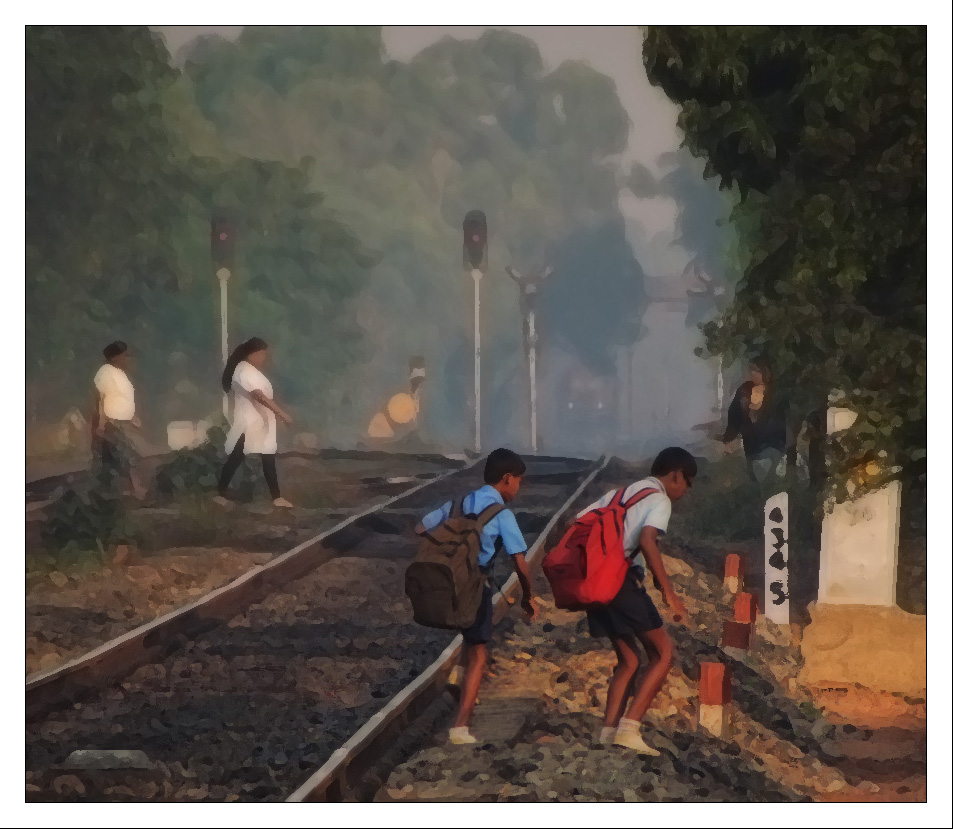
Well, that way I could take an unscheduled crossing picture at Majorda: to the left 56962 Vasco - Kulem Passenger, which I had taken the day before, rolled into the station behind Gooty WDG-3A 14625.
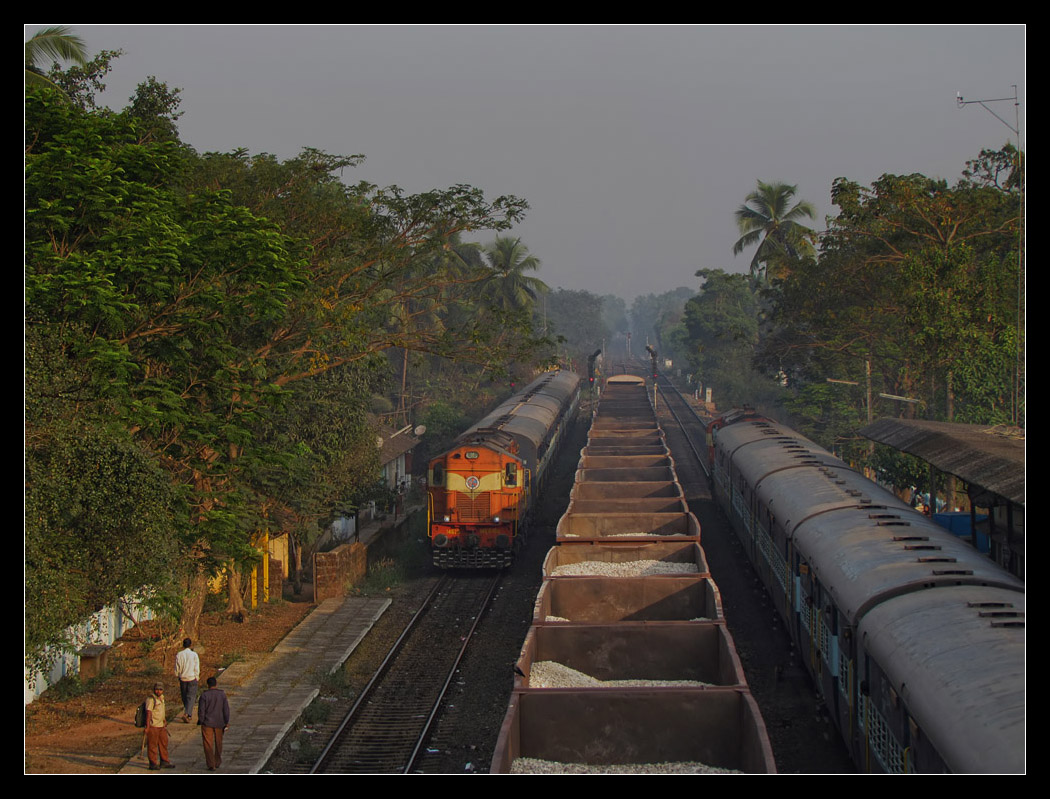
I quickly sprinted across the footbridge and looked for a good seat. Especially after Madgaon, where most commuters disembarked, this was an easy task.

More scenes of the ride can be found in the video from 1h 35:55.
At Madgaon a northbound RoRo hauled by Pune WDG-3A 14565 was waiting, at the doors commuters were ready to get off the local train .
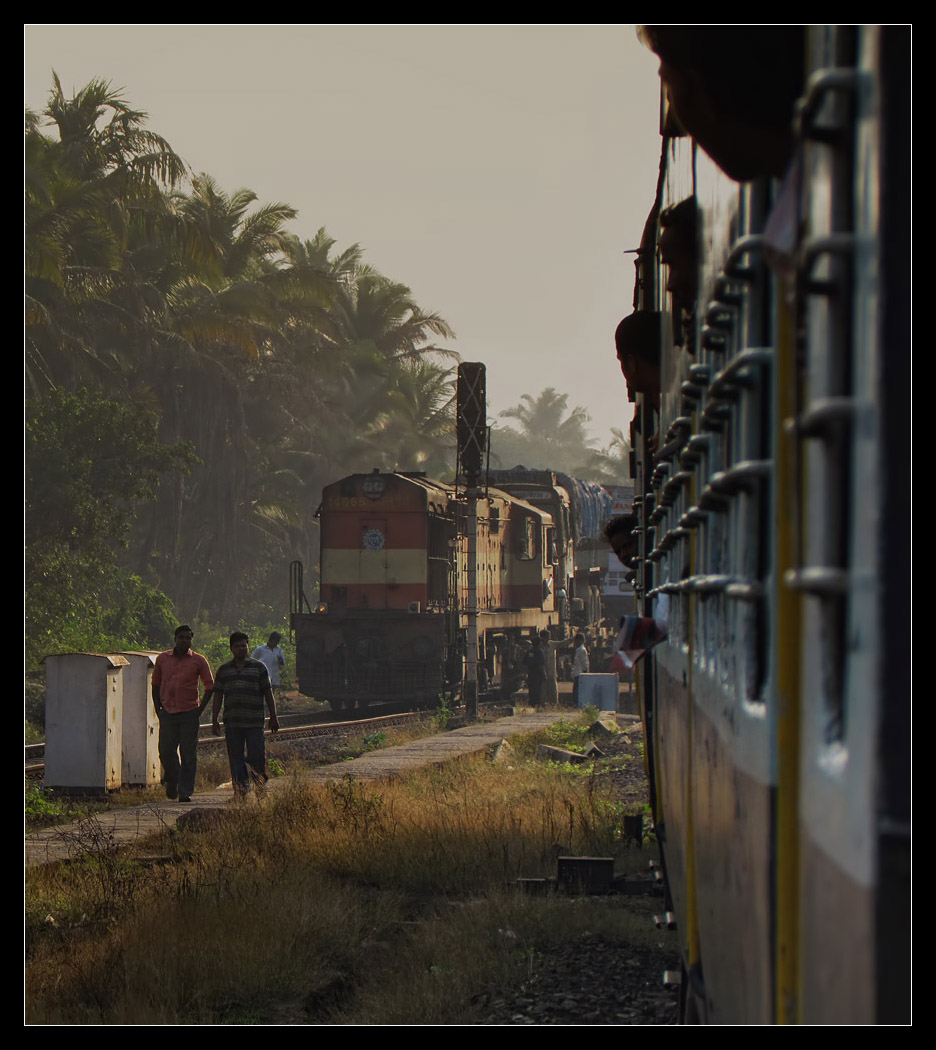
Konkan RoRos differed from their European cousins by absence of a separate passenger coach, so drivers had to stay inside their truck cabins. This led to morning toilette inside stations with truck drivers alleviating themselves off the edge of the cars.
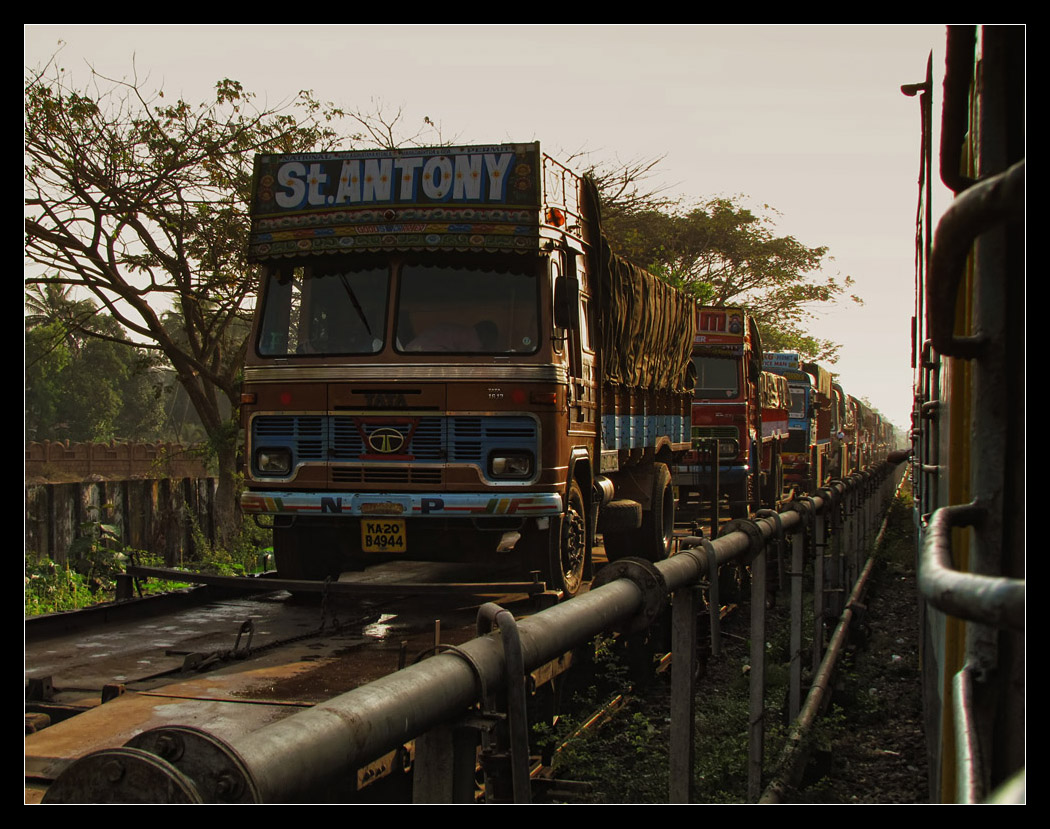
Madgaon fire brigade behind the station in the southwestern corner of the town, that way you had to circuit it coming from Majorda.
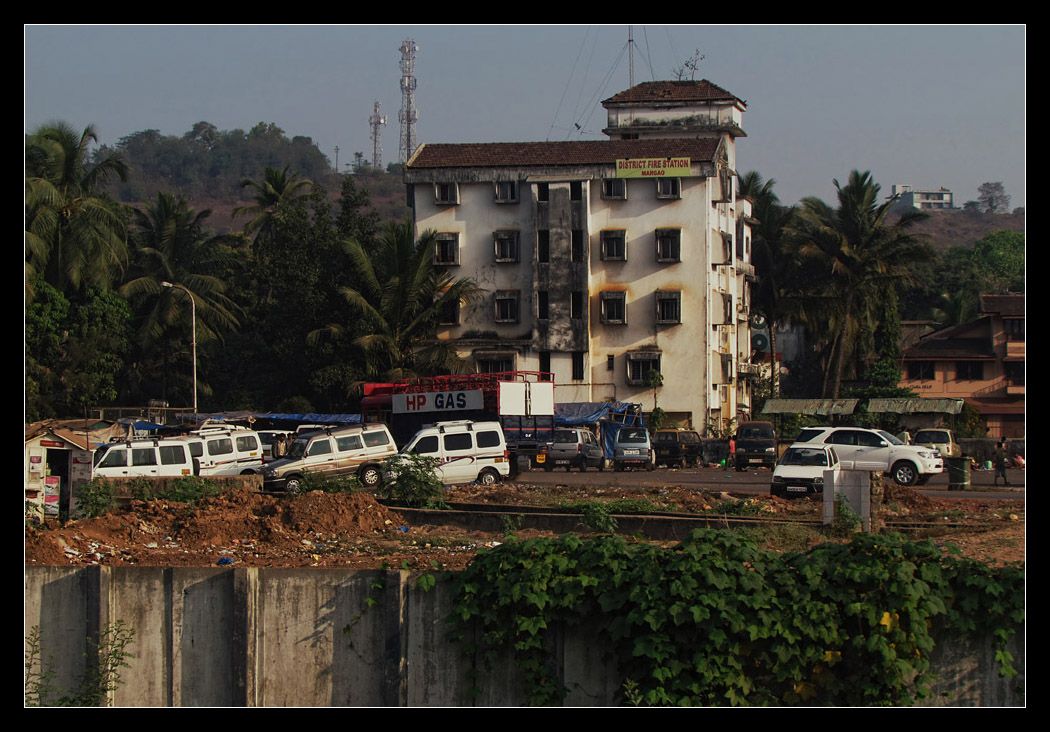
Subsequently my train turned inland, while Konkan Railway continued southwards along the coast. At first we passed through flat countryside, sometimes in tropical green, sometimes dried out containing much poorer villages due to lack of tourism.
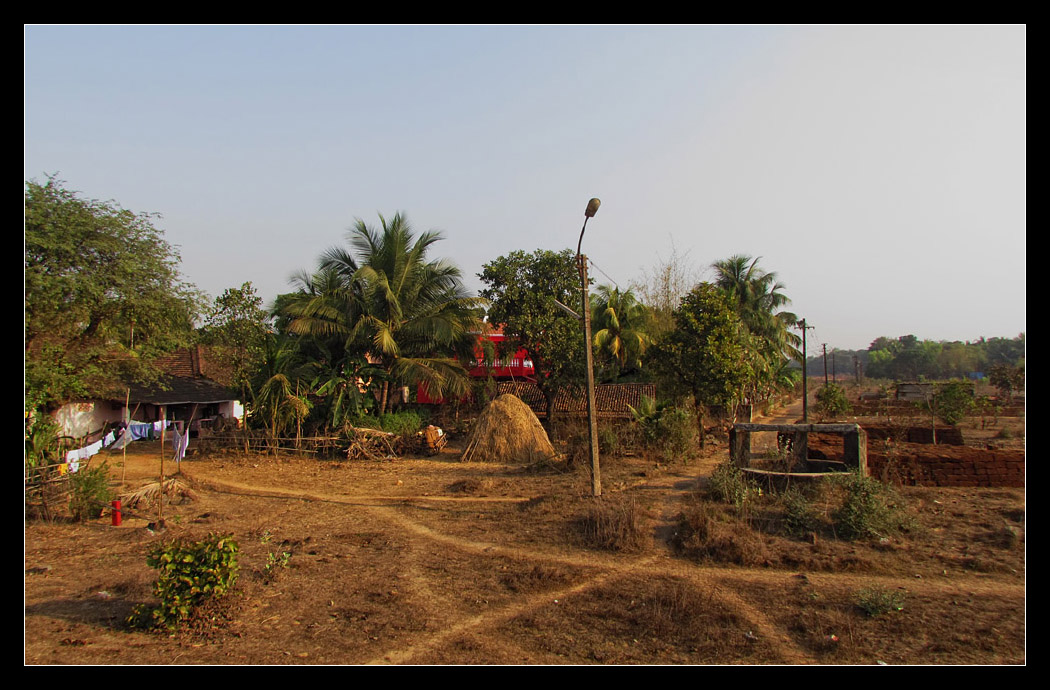
My little neighbour sitting opposite at Chandor station.

I calculated on a train crossing, but nothing came along.
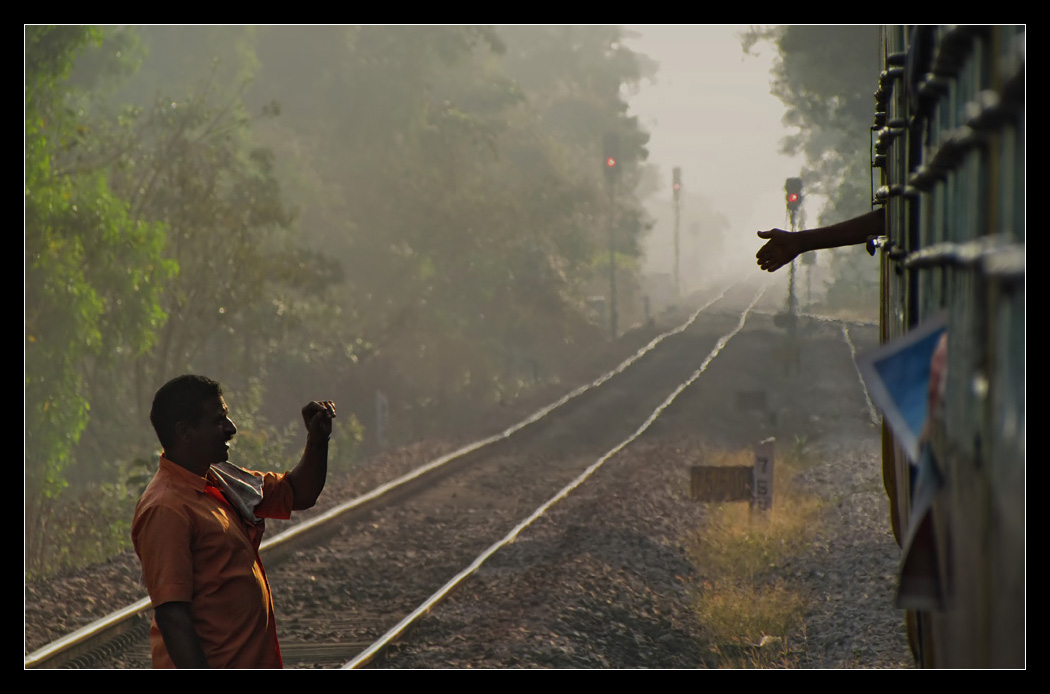
We rode past extensive palm groves watered by river arms.
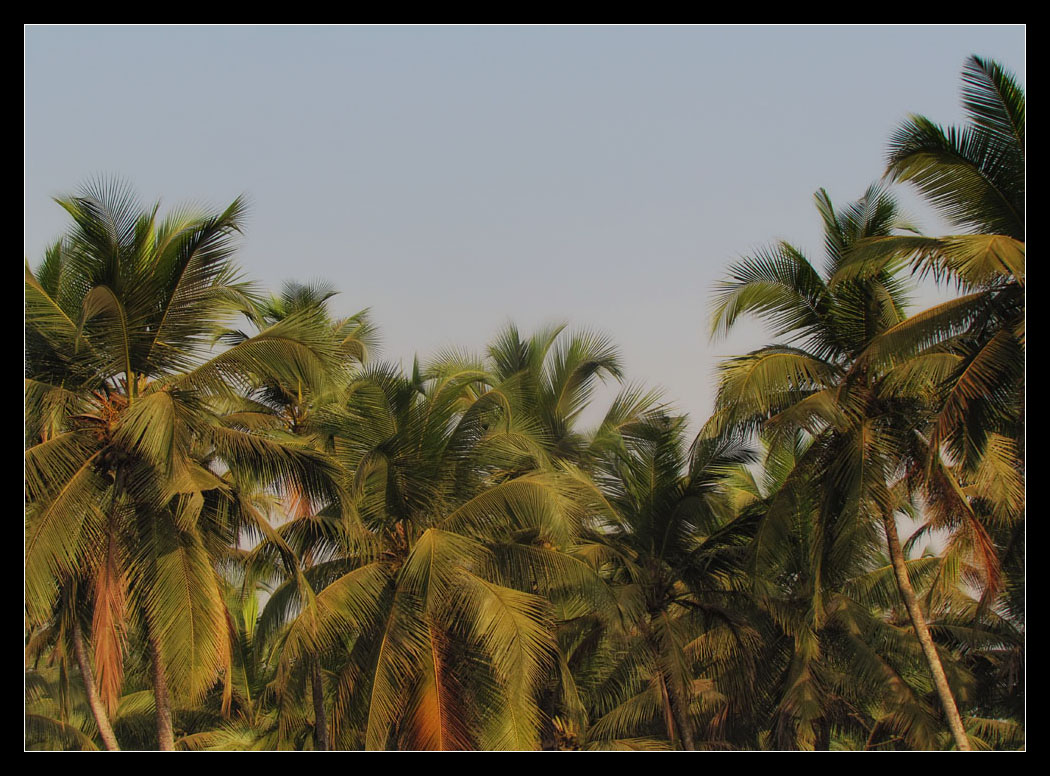
At Sanvordem, the largest intermediate station of Madgaon - Kulem section, we were once again greeted by empty mainline tracks. Only the platform proved to be far from empty with obviously a whole school going on a Saturday excursion.

On the yard tracks: once more a blast from home - Plasser.

Now we continued on a more curvy routing under constant ALCO-chugging towards Kulem.
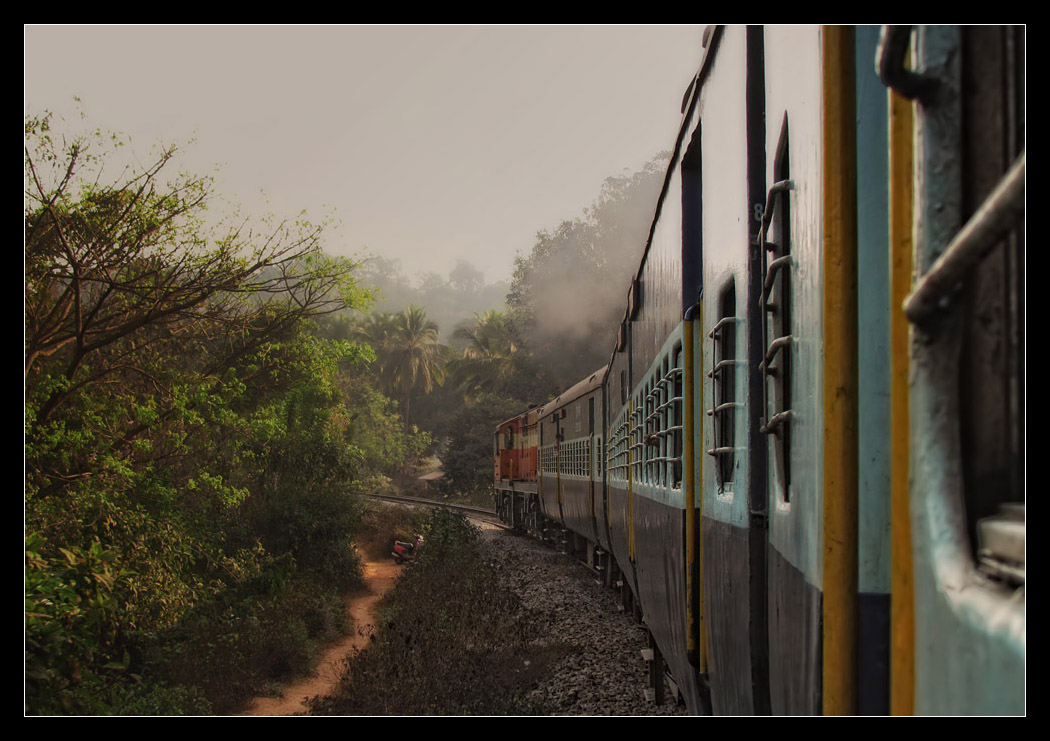
Not that I had been alone since Sanvordem, but it was only a short way to go...


In the surroundings of the next town, Kalem (not at all confusing), manganese and iron ore was mined, you could witness several workers walking around carrying pickaxes. Due to ore-rich soil the whole are was covered in red dust, you can hardly imagine it, but I saw entire red, dusty forests!

Arrived at Kulem - with U - , and yes, the image is straight!
The school now left the passenger train, it had finished its journey on a dead-end track which obviously had partly subsided into the ground.

Three uphill freight trains waited for departure, but no bankers were on site yet. Units of three Hubli class WDG-4s were in operation, most of the freights were also pulled by GMs. I rushed on to the jeep stand, as one of my dream-destinations was scheduled next: Dudhsagar Falls, which were crossed by the railway line via a bridge. You had the option to walk 10 kilometres to reach it, take a banker loco or a jeep. As I had planned something else for the afternoon I chose the most expensive alternative (about 30 Euro for the whole Jeep, a fraction if you wait for other tourists) - since I was here for once in my life it would have been the wrong moment to be cheap. Immediately my jeep with driver and guide set into motion, I wanted to return for the passenger at 12:20. Additionally, the once weekly express from Chennai was supposed to arrive at 11:00 in Kulem, and I definitely wanted to catch a train at the waterfall. There you could wait for a freight or hope for one of the scarce express trains. We started a 45 minute drive, mostly over rough forest roads, sometimes through rivers. Still, I had a very modern Jeep and good driver, so it posed no problem. Only a limited number of jeeps and drivers possessed a license for the Mollem national park starting here (see http://en.wikipedia.org/wiki/Bhagwan_Mahaveer_Sanctuary_and_Mollem_National_Park ), they were managed by a dispatcher who also collected the fees. Entering the national park you had to once more pay a charge for entrance and cameras, but after that we came across no more obstacles apart from natural ones. Everywhere along the route funnel-web spiders had built their traps. There were supposed to live plenty of snakes here, cobras, pythons, rattlesnakes, as well as leopards. We passed the railway tracks shortly behind Kulem in the forest at the same level.
Crossing a river.
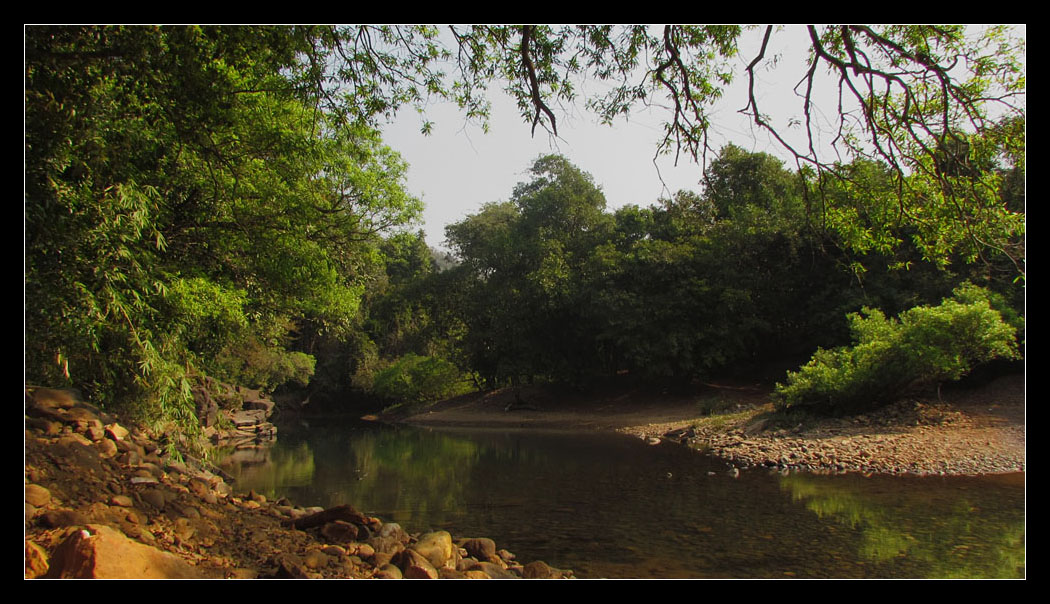
Termite problem?

Cashew tree blossoming, with red dust layer.

A few people lived and worked inside the national park - here a cashew farm, nuts were being distilled to alcohol - but the hut could equally have come right out of a Western movie, with the tomb of the unknown stranger in front!
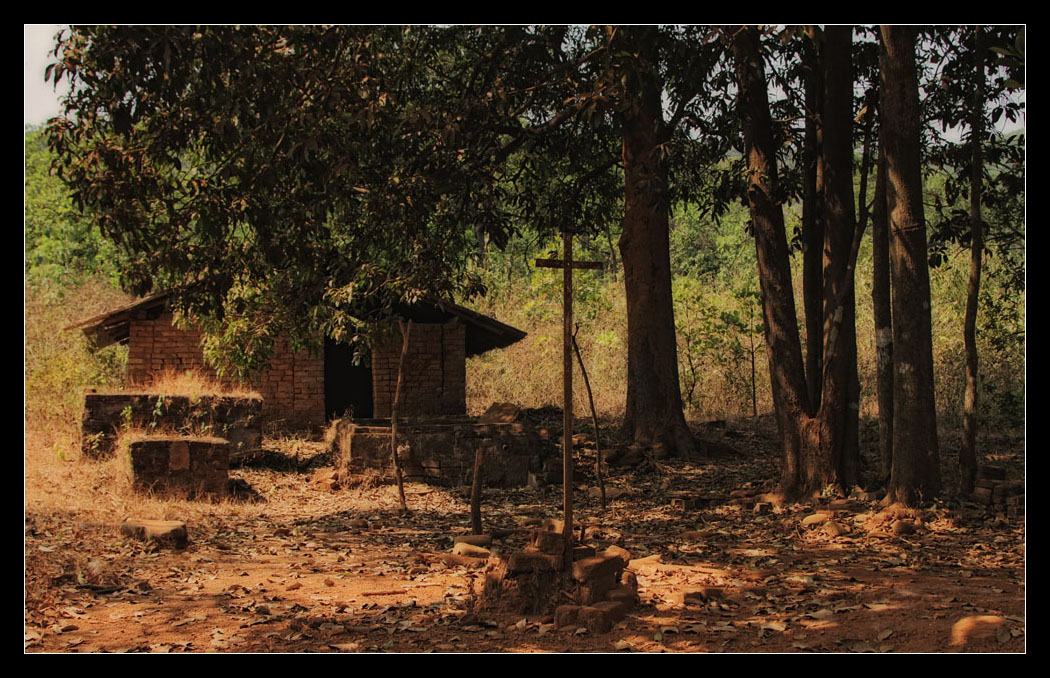
On a clearing I saw the railway line for the first time up on the mountainside, it had significantly gained altitude after surrounding the whole valley.

And a first glimpse of Dudhsagar Falls through jungle trees at the end of the valley.
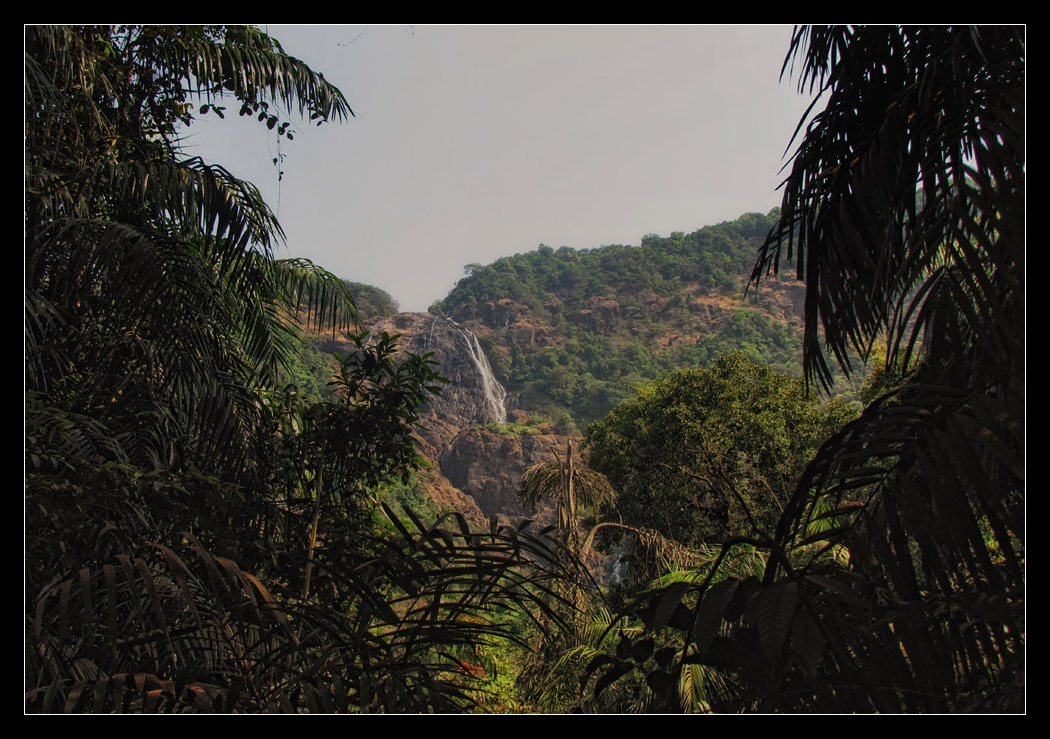
Finally we reached the parking lot close to the falls. A few jeeps had already parked here, before I had not seen any other human beings or oncoming vehicles. From here you still had to walk about 100 metres, through quite gorgeous jungle, if not untouched by people. Some monkeys were at home here, attracted by the human presence. Shortly before reaching the first viewpoint I heard a train horn above me, I legged it and skipped across rocks - would it be enough to reach the once weekly express from Chennai?
In the next part we will have enough time for some stress-free jungle impressions taken with the big camera - and a train ride to a railfan's dream beach!
The previous trip report part:
India 2012 - 18: Goa - Diesel in Paradise I: Kickoff! (50 p.)
http://railroadforums.com/forum/showthread.php?t=40388
The accompanying video:
http://www.youtube.com/watch?v=Ln9ntoVBVts&hd=1
As promised we start this trip report part with an overview of railway lines in Goa. On one hand these entail the Konkan Railway westcoast mainline, leading from Mumbai suburbs (Roha) via Goa to Mangalore (Tokur). The complete route of 738 km total was opened in 1998, the reason for this late build was the rugged terrain of the coast region called Konkan. It consists of broad river deltas with swamps and mangrove forests as well as mountainous areas. More about the railway here: http://en.wikipedia.org/wiki/Konkan_Railway
The other railway line is the original route, which climbs the Deccan Plateau through the Ghats as we already have seen elsewhere. Until the completion of Konkan Railway Goa could only be reached via this detour. The mountain line from Kulem to Castle Rock is called Braganza Ghat, supposedly after a shepherd who had discovered this passage. Castle Rock already lies outside of Goa and previously served as toll station for the former Portuguese colony. The line leads to the most lively town of the region, Madgaon (also Margao), then parallel to the Konkan Railway and from Majorda as branch line to Vasco da Gama. Broad gauge infrastructure is relatively new here, as often in India this used to be a metre gauge line operated by steam. Ranjit from Pune told me a nice anecdote from his childhood when steam drivers used to stop at his house because they knew he would serve them tea. It simply was a different time and life pace back then.
I marked all important spots which will occure in the reports. Next a local train journey to Kulem was scheduled. On the route Vasco - Kulem three local passenger train pairs were operating, further on Braganza Ghats there was no regional traffic anymore, shown stations did not feature any regular stops. Some tourists and natives were using banking locos for local rides.

18. 2. 2012
Early in the morning a commom guest on the lawn outside my room, later I would catch it in sunlight as well.

This was supposed to be the Goa exploration day, I hit the road at 6:30 a.m., three kilometres on foot as taxis in Goa could mainly be caught inside the centres, in front of the resort only at later times. However, it was no problem to reach Majorda station. On the way I already acquired a taste of the different, but equally not-so-different culture of Goa compared to the rest of India. Christianity was practiced the same way as most other religions: with shrines everywhere, large inscriptions on vehicles and painted figurines, in other words: loudly and colourfully. On the road I came across a minibus with the windshield-wide writing "Ratzinger". I crossed the centre of my village, Betalbatim, with school, shops and church. Everything exuded the mood of a mixture between India and Brazil.
The parish of Betalbatim was founded in 1630, the current church "Our Lady of Remedios" originated from 1809.

Subsequently I had to walk cross country, on fields and swamps a picturesque layer of ground mist had formed.


Foggy sunrise.



The final road section up to Majorda.


Yeah, right!

Once more a little different than the rest of India!
Below: a Nokia ad.

Yes, my favourites in India: faded advertisement paintings.

Finally arrived at the level crossing north of Majorda Junction, spanning both parallel lines.

Many schoolchildren passed by, in the foreground the level crossing barrier crank.

I handed a copy of my photo permit to the crossing guard, who later talked on the phone about it, often laughing. General mood seemed to be quite relaxed here, and of course people were used to tourists taking pictures.

Old list of gatemen on the wall below the roof of the hut, probably this method of data storage was not in use anymore.

I waited for the Kulem Vasco passenger which was supposed to depart earlier than my train, crossing it at Cansaulim as can be seen in the previous report. But nothing happened at the scheduled time and the guard told me that the train to Kulem would come first. So, I walked along the tracks towards the station. Shortly later a bell sounded at the crossing and I took up position behind a stabled freight rake.
The gates were still open but in the back you could already spot an express approaching on the Konkan Railway, to the left the line to Vasco, it branched off a little further north.

The gateman did his duty, and the barriers were closed.

Ernakulam WDM-3A pulled 16335 "Nagercoil Express" towards its destination at the southern tip of the subcontinent.

Cocos dominated the surroundings.

I moved to platform 1 of Majorda Junction, but finally 56961 Kulem - Vasco Passenger came first, about 20 minutes late.


Like on the day before a tractionless freight rake stood on the middle track.


The locos of both local trains remained the same during my stay, here once more Gooty WDG-3A 14586.

From now almost all photos were taken by compact camera.
I chatted with the loco crew, they thought their train would depart first.

I prepared for a video shot, but then they called me back because the other train was already nearing as can be spotted in this tryout of a painting.

Well, that way I could take an unscheduled crossing picture at Majorda: to the left 56962 Vasco - Kulem Passenger, which I had taken the day before, rolled into the station behind Gooty WDG-3A 14625.

I quickly sprinted across the footbridge and looked for a good seat. Especially after Madgaon, where most commuters disembarked, this was an easy task.

More scenes of the ride can be found in the video from 1h 35:55.
Code:
56962 VSG KULEM PASSENGER
1 VSG Vasco Da Gama 07:35 SWR 0 1
2 DBM Dabolim H 07:39 07:40 1 SWR 5 1
3 SKVL Sankaval 07:44 07:45 1 SWR 8 1
4 CSM Cansaulim 07:49 07:50 1 SWR 13 1
5 MJO Majorda 07:59 08:00 1 KRCL 17 1
6 SRVX Suravali H 08:05 08:06 1 KRCL 21 1
7 MAO Madgaon 08:09 08:11 2 KRCL 28 1
8 CNR Chandar Goa 08:19 08:20 1 SWR 37 1
9 SVM Sanvordem Chuch 08:28 08:30 2 SWR 44 1
10 KM Kalem 08:44 08:45 1 SWR 54 1
11 QLM Kulem 09:10 Last Stn SWR 62 1At Madgaon a northbound RoRo hauled by Pune WDG-3A 14565 was waiting, at the doors commuters were ready to get off the local train .

Konkan RoRos differed from their European cousins by absence of a separate passenger coach, so drivers had to stay inside their truck cabins. This led to morning toilette inside stations with truck drivers alleviating themselves off the edge of the cars.

Madgaon fire brigade behind the station in the southwestern corner of the town, that way you had to circuit it coming from Majorda.

Subsequently my train turned inland, while Konkan Railway continued southwards along the coast. At first we passed through flat countryside, sometimes in tropical green, sometimes dried out containing much poorer villages due to lack of tourism.

My little neighbour sitting opposite at Chandor station.

I calculated on a train crossing, but nothing came along.

We rode past extensive palm groves watered by river arms.

At Sanvordem, the largest intermediate station of Madgaon - Kulem section, we were once again greeted by empty mainline tracks. Only the platform proved to be far from empty with obviously a whole school going on a Saturday excursion.

On the yard tracks: once more a blast from home - Plasser.

Now we continued on a more curvy routing under constant ALCO-chugging towards Kulem.

Not that I had been alone since Sanvordem, but it was only a short way to go...


In the surroundings of the next town, Kalem (not at all confusing), manganese and iron ore was mined, you could witness several workers walking around carrying pickaxes. Due to ore-rich soil the whole are was covered in red dust, you can hardly imagine it, but I saw entire red, dusty forests!

Arrived at Kulem - with U - , and yes, the image is straight!
The school now left the passenger train, it had finished its journey on a dead-end track which obviously had partly subsided into the ground.

Three uphill freight trains waited for departure, but no bankers were on site yet. Units of three Hubli class WDG-4s were in operation, most of the freights were also pulled by GMs. I rushed on to the jeep stand, as one of my dream-destinations was scheduled next: Dudhsagar Falls, which were crossed by the railway line via a bridge. You had the option to walk 10 kilometres to reach it, take a banker loco or a jeep. As I had planned something else for the afternoon I chose the most expensive alternative (about 30 Euro for the whole Jeep, a fraction if you wait for other tourists) - since I was here for once in my life it would have been the wrong moment to be cheap. Immediately my jeep with driver and guide set into motion, I wanted to return for the passenger at 12:20. Additionally, the once weekly express from Chennai was supposed to arrive at 11:00 in Kulem, and I definitely wanted to catch a train at the waterfall. There you could wait for a freight or hope for one of the scarce express trains. We started a 45 minute drive, mostly over rough forest roads, sometimes through rivers. Still, I had a very modern Jeep and good driver, so it posed no problem. Only a limited number of jeeps and drivers possessed a license for the Mollem national park starting here (see http://en.wikipedia.org/wiki/Bhagwan_Mahaveer_Sanctuary_and_Mollem_National_Park ), they were managed by a dispatcher who also collected the fees. Entering the national park you had to once more pay a charge for entrance and cameras, but after that we came across no more obstacles apart from natural ones. Everywhere along the route funnel-web spiders had built their traps. There were supposed to live plenty of snakes here, cobras, pythons, rattlesnakes, as well as leopards. We passed the railway tracks shortly behind Kulem in the forest at the same level.
Crossing a river.

Termite problem?

Cashew tree blossoming, with red dust layer.

A few people lived and worked inside the national park - here a cashew farm, nuts were being distilled to alcohol - but the hut could equally have come right out of a Western movie, with the tomb of the unknown stranger in front!

On a clearing I saw the railway line for the first time up on the mountainside, it had significantly gained altitude after surrounding the whole valley.

And a first glimpse of Dudhsagar Falls through jungle trees at the end of the valley.

Finally we reached the parking lot close to the falls. A few jeeps had already parked here, before I had not seen any other human beings or oncoming vehicles. From here you still had to walk about 100 metres, through quite gorgeous jungle, if not untouched by people. Some monkeys were at home here, attracted by the human presence. Shortly before reaching the first viewpoint I heard a train horn above me, I legged it and skipped across rocks - would it be enough to reach the once weekly express from Chennai?
In the next part we will have enough time for some stress-free jungle impressions taken with the big camera - and a train ride to a railfan's dream beach!
